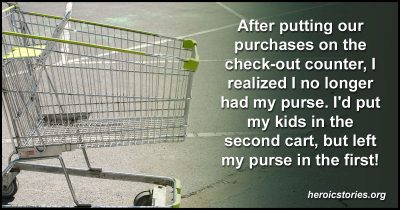by Linda M. Easterbrooks
Maine, USA
Last week, I went to a huge chain store. It’s so big I usually end up overwhelmed before finding what I’m looking for; even the parking lot is bigger than I’d like. When I go, I park beside a stray shopping cart so I can put Phillip, who is two years old, into the shopping cart and have Teresa, who is five, walk beside me into the store. When we reach the entryway, we swap to a two-child cart so they can both ride.
 It was a typical shopping trip. We looked at dog food, pool toys, children’s shoes, and sweatpants in both girls and boys sections. Teresa eventually decided she wanted to walk, but I don’t let her wander by herself. Besides, those two-kid carts are hard enough to steer with two children in them; with one child, they’re nearly impossible. When I’d had enough, we headed toward the front with a bag of dog food and a T-shirt to color for Grandma for Mother’s Day.
It was a typical shopping trip. We looked at dog food, pool toys, children’s shoes, and sweatpants in both girls and boys sections. Teresa eventually decided she wanted to walk, but I don’t let her wander by herself. Besides, those two-kid carts are hard enough to steer with two children in them; with one child, they’re nearly impossible. When I’d had enough, we headed toward the front with a bag of dog food and a T-shirt to color for Grandma for Mother’s Day.
After putting our purchases on the check-out counter, I realized I no longer had my purse. I’d put my kids in the second cart, but left my purse in the first! So I went back to the entrance. The greeter remembered me leaving my purse; he had taken it to customer service. Customer service remembered it, but had locked it in accounting. They had to find the person with the right key, so it took a bit to actually get the purse.
There wasn’t anything particularly valuable in my purse, but I wasn’t wearing a jacket, so my car keys were in the purse instead of a pocket. That could have been inconvenient, at the very least. I was trying unsuccessfully to think of *any* backup plan that would not involve calling my husband to come with his keys.
My children got a lesson in doing the right thing — turning in the purse — and in believing someone else *would* do what was right. I told them that most people are honest, and I expected to find that someone turned it in. I think it’s easier to do the wrong thing if you believe everyone else is that way. If you believe most people are good, it’s easier to join the crowd and be good, too.
Normally, my daughter doesn’t carry a purse, but that day she brought a little white purse with a couple of quarters in it. As we were leaving the store, she realized she’d left her purse behind, too. (Like mother, like daughter?) We retraced our steps hoping to find it in the store, so I wouldn’t have to tell customer service we’d lost another item. But her purse had indeed been turned in, and the staff gave it to us with a smile.
I do feel that the belief in good actually creates good. I’m always happy to show my children that people will do the right thing — and people usuaslly prove me right.
Podcast: Play in new window | Download (Duration: 4:07 — 2.0MB)


I know this happened a long time ago, but a good solution to this problem is to put the five-year-old in a child harness with a lead. As Wikipedia says, “When the device is used, a child wears the harness and a parent or a guardian holds the end of the lead or attaches it to their wrist. This allows the child relative freedom of movement in comparison to being seated in a stroller, carried by the adult (with or without a child carrier), or being held by the hand. At the same time, the child harness prevents child separation from the adult by the way of the child running off in a crowded or dangerous area.” I used them with my daughter and my grandson, both very impulsive children, with great success. In this case, the lead could be tied to the one-child cart, thus eliminating any need for transfers.
How true — we DO live up to our expectations, and expect others to live up to our expectations of them.